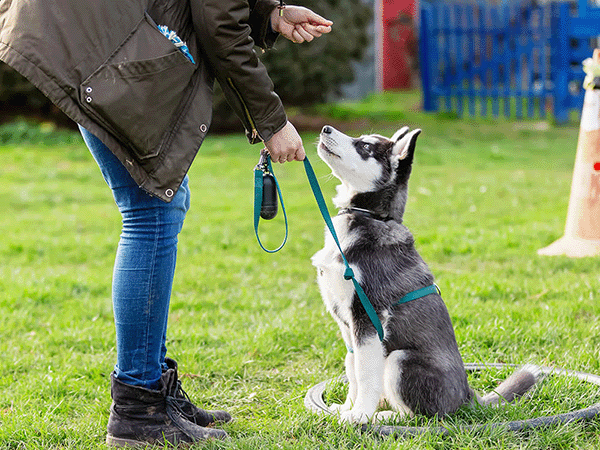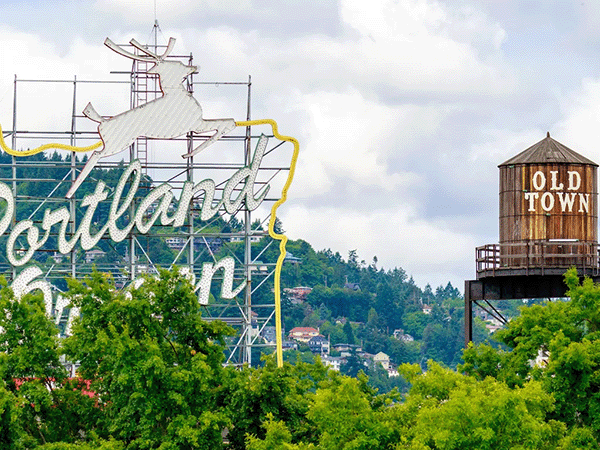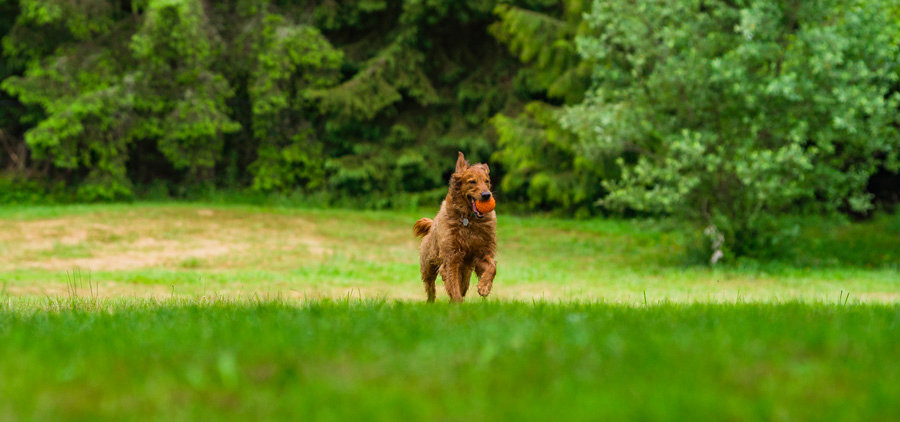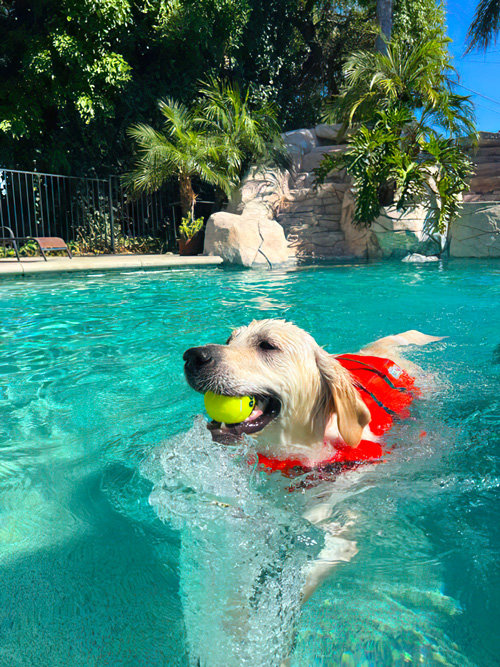How to Teach a Dog to Lie Down: A Practical Guide

Teaching your dog to lie down on cue is a game-changer. It's more than just a simple trick—a solid "down" creates a calmer, more responsive companion. This guide breaks down how to teach a dog to lie down, offering clear steps for dog owners of all experience levels. Whether you're navigating a busy Sniffspot or just chilling at home, a reliable down makes life easier for both of you. Let's get started.
Just because lying down is a common position doesn’t mean teaching this trick is always a cake walk, though. That’s why we’ve put together a guide outlining how to train your dog to lie down—and helping you troubleshoot common issues along the way.
Let’s dive in!
Why is it valuable for your dog to know how to lie down?
The ability to lie down on cue comes in handy in real-life scenarios
Down is a great position for your dog to be in when you:
- Hang out at a coffee shop or restaurant patio
- Chat with your neighbor on the sidewalk
- Greet guests inside your home
- Want your companion to settle in a busy environment
- Are hanging around other dogs and want to ensure your pup’s posture is non confrontational
- And so on
Lying down can be a foundation for more advanced behaviors
What’s more: A solid knowledge of how to lie down when asked sets your dog up to learn more advanced skills! These include tricks like roll over, go to bed, play dead, and more.
Down is also a naturally more relaxed position than a sit or stand, which means it’s ideal for duration or distance stays (whether you compete in dog sports or just need your dog to stay put while you get the mail).
Key Takeaways
- "Down" is more than just a trick: Teaching "down" offers practical benefits for managing your dog in various situations, builds a foundation for more complex commands, and can even help your dog relax in stimulating environments.
- Find the right training approach for your dog: Consider your dog's unique personality and physical comfort when choosing a training method. Luring, capturing, and shaping each offer unique advantages depending on your dog's learning style.
- Real-world practice is essential: Help your dog generalize the "down" cue by practicing in different locations and gradually increasing distractions. Keep training sessions short, positive, and focused on rewarding progress.
The Importance of "Down" as a Foundation for Other Commands
Calming Your Dog
Teaching your dog to lie down isn’t just about obedience—it’s a valuable tool for helping your dog relax. A dog in a “down” position is naturally more relaxed and submissive, making it an effective way to diffuse stressful situations. This can be especially helpful in busy or unfamiliar environments, like a Sniffspot, allowing your dog to feel secure and calm amidst the excitement. The American Kennel Club (AKC) emphasizes the calming effect of "down," noting its usefulness in managing a dog's energy levels and promoting relaxation. A relaxed dog is a happy dog, and "down" can be your secret weapon for achieving just that.
If your dog struggles with reactivity, teaching a solid “down” can be a game-changer. Practicing “down” regularly can help your dog learn to self-soothe and better manage their impulses. When they encounter a trigger, cueing the “down” can redirect their focus and encourage a calmer response. This can be particularly useful when combined with other calming techniques, such as deep breathing exercises for dogs.
Building a Foundation for "Stay" and Other Commands
The “down” cue isn’t just a standalone command; it’s a foundational skill that unlocks a world of more advanced training. Mastering “down” paves the way for learning other essential behaviors, such as “stay” or “place.” The AKC highlights the importance of "down" as a prerequisite for more complex commands, stating that it forms the basis for building a well-rounded training repertoire. Think of it as a building block: once your dog understands “down,” you can layer on additional cues and behaviors, creating a more complex and nuanced communication system.
Because lying down is a more relaxed position than sitting or standing, it’s ideal for duration or distance stays. Whether you’re working on a rock-solid stay at home or training for competitive dog sports, a reliable “down” is essential. This is especially true in stimulating environments, like dog water parks, where distractions abound. A well-trained "down-stay" can provide your dog with a sense of security and structure, allowing them to enjoy the fun while remaining under control.
What you need to teach your dog to lie down
Dog Training Basics
We’ve put together a longer guide that dives into dog training basics—from operant and classical conditioning to a canine’s unique cognitive experiences and more. Take a look at Dog Training 101 here!
If you aren’t able to scan the whole piece, that’s okay. We cover all the most important concepts and supplies you need to teach your dog to lie down below.
A reinforcer (like treats or a favorite toy)
When we ask our dogs to work for us, it’s only fair we pay them. Reinforcers (often called rewards in everyday conversation) are things 1) our dogs love that 2) are easy for us to give them during a training session.
Common reinforcers include:
- Store-bought dog treats
- Small pieces of human food (like meat or cheese)
- Your dog’s kibble (if they’re particularly food motivated, have a sensitive stomach, or you need to be calorie conscious)
- A favorite toy
If possible, let your dog decide what they like best. Consider setting out multiple rewards, seeing which one they go to first, and choosing that to teach new behaviors! (You can also vary between a few favorites to keep them interested.)
The more excited your dog is for their reinforcer, the more motivated they’ll be during your training session.
A conditioned reward marker
If you’ve heard of “clicker training” (first popularized by marine mammal trainers) you’ve been exposed to the idea of a reward marker.
In technical terms, a marker is a conditioned stimulus that predicts a primary reinforcer. Put more simply? A reward marker is a sound or signal that “marks” exactly what your dog did to earn their reinforcement. This makes it possible for us to communicate clearly during training sessions—even if we’re unable to deliver a treat precisely when our dogs offer the right behavior.
Common reward markers include:
- Clickers
- “Yes”
- “Good”
- A thumbs up (particularly useful for deaf dogs)
- Other easy-to-make noises
No marker is inherently better than the others. What matters is that you pick one that works for you and stick to it! Consistency is key.
How to charge your reward marker
To make sure your dog understands that your marker sound or signal predicts a reward, spend a few sessions conditioning them to the stimulus. (If you already use reward markers in your training, skip on to the next section.)
You can charge your dog’s reward marker by:
- First making your noise or visual signal
- Pausing for a second
- Then giving your dog their reward—this turns your chosen marker into a predictor of good things to come
- Repeating multiple times!
Eventually your dog will start to respond to the noise itself. They might run towards you before you even reach for their treat or toy. This indicates they’re forming the right association!
How to use your reward marker in a training session
Once your dog is conditioned to your chosen reward marker, you can start using it in training sessions to teach new skills.
It’s important to mark the right behavior the instant your dog performs it. Accurate timing makes for more effective teaching. And remember to always follow your marker with a reward—you have about 1.5 to three seconds to deliver reinforcement, give or take, to keep up your dog’s conditioned association.
Patience
Before working with your dog, make sure you’re in a good headspace. It’s not always easy to communicate with another species. Even simple behaviors like lying down on cue can confuse our pets at first!
Be prepared to take things slowly and keep your training sessions upbeat. Offer lots of praise and affection when your dog makes an effort—and keep things simple to get more buy-in from your dog. This is especially important if they’re an adolescent.
Choosing the Right Training Environment
Set your dog up for success by creating a learning-friendly environment. Start training in a quiet space inside your home. Minimize distractions—turn off the TV, put away noisy toys, and ask other members of your household to give you some space. If you share your home with other pets, work with your dog in a separate room. Have some high-value treats handy, too. The goal is to help your dog focus on the task at hand without being overwhelmed by external stimuli (RSPCA).
Minimizing Distractions
A tired pup is more receptive to learning. Train when your dog is tired, not overly energetic (AKC). This makes them less likely to be distracted by their surroundings. Remember, different dogs learn at different paces. Adjust your approach based on your dog’s learning style (AKC). Some dogs are highly motivated by food, while others prefer toys or praise. Tailor your training to your dog’s unique needs to minimize distractions and improve focus. If your dog is still struggling to concentrate, try using a visual barrier to block distractions. This could be as simple as holding up a blanket or standing in front of a wall.
Using Soft Surfaces
Start practicing the “down” command on a soft surface like a couch, dog bed, or rug. This can help your dog feel more comfortable and secure while learning (Reddit). Once they master “down” on the soft surface, gradually transition to harder surfaces like the floor. This gradual approach builds confidence and ensures your dog associates the command with the behavior, not the surface.
Optimal Training Session Length and Frequency
Keep training sessions short, sweet, and positive. Dogs learn best when they’re engaged and not feeling stressed (Chewy). Aim for sessions no longer than five to ten minutes, especially when teaching a new skill. Practice in short, frequent sessions to keep your dog engaged and reinforce what they’ve learned (Chewy). Several short sessions spread throughout the day are more effective than one long session. Consistency is key. Regular, brief training sessions lead to better retention of skills. Looking for dog-friendly places to practice? Check out Sniffspot's dog parks near you! Filter by features like water parks to make training extra fun.
How to train your dog to lie down
Now that we have all the necessary supplies, it’s time for the nitty gritty. Here are step-by-step instructions to teach your dog their new down cue!
You can choose between a few training techniques outlined below.
Luring: Train down by luring your dog into position
Luring is the most common method to teach our dogs new skills. It’s especially great for pets who are easily distracted or crave constant feedback from their owners.
Here’s how to teach your dog to lie down using luring:
- Start by holding your dog’s reward (a high value training treat or favorite toy) in your hand. You can put it in your palm or between your fingers, depending on the size and intensity of your dog.
- Move the reward in front of your dog’s nose. They can be in either a sitting or standing position, though it’s usually easier from a sit to begin with.
- Slowly lower your hand towards the ground, so that your dog’s snout points to the floor as they follow your lure.
- As your dog looks downward, they should lower their front elbows and then their back legs.
- Adjust your lure based on your dog’s positioning. Some pups lean too far forward—others don’t follow the tasty treat or fun toy as closely. Experiment to find what works best for your own pup!
- The moment your dog’s stomach hits the ground in a lying down position, mark and reward! Praise and release them to try again.
- Repeat this multiple times until your dog begins anticipating the movement of the lure and falling into position more quickly.
- If your dog is reluctant to follow the lure at all, try practicing in a separate session. Reward them for keeping their nose near your hand, even if it’s just small movements at first.
- Don’t be afraid of taking baby steps—eventually your dog will start to understand that following the lure leads to reinforcement!
Luring Under Legs/Bridge
One effective technique for teaching your dog to lie down is to use a lure to guide them under your legs, creating a bridge-like effect. This method not only encourages the desired behavior but also adds an element of fun to the training process. As you hold a treat in front of your dog’s nose, slowly lower it towards the ground while moving your legs apart. This encourages your dog to follow the lure and position themselves in a lying down posture to get the treat. The moment their stomach touches the ground, mark the behavior and reward them. This technique can be particularly useful for dogs that are easily distracted, as it provides a clear visual cue and a fun challenge. It can also be a good way to add a bit of physical and mental enrichment to your training sessions, especially if you have a high-energy dog.
Phasing Out Lures
As your dog becomes more familiar with lying down on cue, it's important to gradually phase out the use of lures. This helps your dog learn to respond to the command without relying on treats as a prompt. Start by using the lure less frequently, perhaps only giving your dog a treat after every other successful “down.” Then, start incorporating a hand signal. Use the same hand motion you used when luring with a treat, but without a treat in your hand. The moment your dog lies down, mark the behavior and reward them. This transition encourages your dog to understand that the behavior is expected without the lure, reinforcing their learning and building their confidence. Remember, consistency is key; continue to reward your dog for their efforts to maintain motivation and reinforce the behavior. Over time, you can start to increase the three “Ds” of dog training: duration (how long your dog stays down), distance (how far away you are from your dog while they’re lying down), and distraction (how distracting the environment is while your dog is performing the behavior).
Capturing: Teach down by capturing your dog’s offered behaviors
“Capturing” your dog’s offered behaviors—and then “shaping” them into the final picture you want—is another way you can teach your dog to lie down. These sessions tend to be more mentally draining than luring, making them a great option for dogs with excess energy!
Capturing can be frustrating for pets who are anxious or insecure, though, so remember to pay attention to your dog’s body language and change things up if they seem stressed.
Here’s how to shape your dog’s down position:
- Have your reward and marker ready.
- Consider giving your dog a cue that it’s time to start capturing. This can be helpful to avoid confusion about when you want them to offer behaviors and when you don’t!
- Wait until your dog lies down on their own.
- At the exact moment they do, mark and reward!
- If they get “stuck” in the lying down position, toss a training treat off to the side for them to retrieve. This can help them reset so they’re able to offer another repetition.
- Repeat until they start to realize that lying down gets them a reward!
If your dog doesn’t offer you a down position, you can do a few things:
- Make sure the surface is comfortable. Your dog might be reluctant to lie down if the ground is too hard, rough, cold, or hot. You can always work on a soft dog bed or blanket to make things easier.
- If changing the surface doesn’t help, consider using the luring method instead.
- If you’re really committed to shaping, mark and reward small movements towards the desired behavior instead of waiting for the completed position. For example, you could mark if your dog looks down at the ground or sinks into a stretch—and then slowly increase your criteria over time. This can be a complicated (and sometimes confusing) process, but it can also be really fun if you and your dog are into it!
Alternate "Down" Training Methods
Sometimes, the traditional luring and capturing methods don’t quite click for every dog. That’s perfectly normal! There are plenty of other ways to teach the “down” cue. Here are a few alternate training methods to try if your dog is struggling.
Shaping the Behavior
Shaping involves breaking down the “down” behavior into smaller, more manageable steps. Instead of waiting for your dog to lie down completely, you reward successive approximations of the behavior. This means you might click and treat for simply looking down, then for bending their elbows, and finally for lying all the way down. This step-by-step approach can be especially helpful for dogs who find the full “down” movement challenging or confusing at first.
Shaping from the Neck
If your dog isn’t following a lure, try shaping the “down” starting with their neck. Reward your dog for any slight lowering of their head. As they understand what earns them a reward, gradually increase the criteria, rewarding them for lowering their head further and further until they’re eventually lying down. This method requires patience, but it can be effective for hesitant dogs. This video offers a helpful visual demonstration.
Shaping by Bridging
Use a low object, like a stool or a stack of books, as a “bridge” to help your dog understand the down position. Lure or guide your dog under the bridge, rewarding them for lowering their body. As they become more comfortable, gradually lower the height of the bridge until they’re lying down on the floor. This technique can make the transition to a full “down” smoother. You can see bridging in action in this video.
Building from a "Bow"
Many dogs naturally perform a “play bow,” where they lower their front end while keeping their rear end up. You can use this natural behavior as a starting point for teaching “down.” Lure your dog into a play bow, and then slowly move the lure between their front paws, encouraging them to lie down the rest of the way. This method can feel more intuitive for some dogs, as it builds on a behavior they already know. This video shows how to build from a play bow.
"Bathroom Down" (All-or-None Reward)
This method requires a small, enclosed space like a bathroom (hence the name). Go into the bathroom with your dog and some high-value treats. Simply wait for your dog to lie down on their own. It might take a while, so bring a book or your phone. The moment they lie down, mark and reward! After a few repetitions, start saying “Down” just as they begin to lie down. This method teaches your dog to associate the cue with the action without any physical manipulation. See the “bathroom down” method in action in this video.
Add a visual cue (hand signal) to your dog’s down behavior
Once your dog seems to be getting it—either reliably following your lure or offering downs on their own in a capturing session—it’s time to add a visual cue.
If you’ve been luring your dog into position, your hand signal will likely end up as a natural shortening, or smaller version, of that lure. If you’ve been capturing your dog’s behavior, you’ll need to be present to add the cue into the existing picture. This is sometimes difficult—but capturing can be the only low-conflict way to start teaching some reluctant-to-follow dogs. In this case, you can pick any visual cue you want.
Common hand signals for down are:
- A finger pointing at the floor
- A flat palm facing the ground
- A fist moving towards the floor
To start fading your lure in favor of a visual cue:
- Test the waters by giving your lure without a treat in your hand. Does your dog lie down? Fantastic! If they instead seem confused, go back to your lure for now and try again in another session.
- Once your dog can follow your hand without a treat, slowly start shifting from the full motion to just the signal you want to use.
- Always mark and reward correct repetitions!
- Don’t be afraid to take steps back in the process if either of you gets frustrated.
- Eventually your dog will be able to lie down on just your visual cue.
(Most dogs find it easier to pay attention to our body movements than our words, but that isn’t a hard-and-fast rule. If you know your dog is particularly verbal and want to skip the hand signal to go right to a verbal cue, feel free! Just remember to change things up if your pup is struggling, as some dogs will get so frustrated they check out completely.)

Add a verbal cue to your dog’s new skill
To add a verbal cue, pair your new learned behavior stimulus—the word “down” or “lie” or whatever you choose—with your dog’s already-known hand signal:
- Say “down” (or your chosen cue word)
- Pause for just a breath, then immediately give your visual cue
- If your dog responds, mark and reward!
- Repeat several times
- Eventually your dog will start to lie down right when they hear your verbal instead of waiting for the hand signal
Some dogs have a difficult time separating the pieces of a training picture from each other. If your dog is struggling to learn a verbal cue, make sure:
- You don’t give the verbal at the exact same time as the hand signal. If you do, your dog might “tune out” the sound in favor of paying attention to your motion.
- You don’t wait too long to give your hand signal after saying your verbal. You want just enough of a pause that your dog separates out the cues—but not so much they can’t make the connection.
Troubleshoot along the way
Are you having a hard time teaching your dog to lie down on cue? Feeling frustrated with training difficulties? Here are some common issues.
Is your dog experiencing physical pain or discomfort?
Some dogs hesitate to lie down on cue because it’s uncomfortable for them due to arthritis, obesity, an acute injury (like a pulled muscle), or chronic health conditions like hip dysplasia.
If you notice that your dog is stiff or seems stressed in your sessions—especially if they used to lie down willingly and now seem reluctant—consider visiting your veterinarian for a pain assessment. They’ll help you come up with a treatment plan to get back in the training groove!
Does your dog understand what you’re asking for?
Our dogs experience the world differently than we do. Sometimes we think we’re communicating one thing when they’re actually perceiving another.
If your dog seems confused about lying down on cue even after multiple training sessions, try to:
- Make sure you always use the same visual and verbal cues.
- Get everyone in your household on the same page about what signals and words to use for different behaviors.
- Be aware of other subtle body movements that might confuse your dog.
- Practice giving your reward markers on your own, without your dog around, to build muscle memory.
- Video your sessions so you can evaluate your marker and reward timing.
- Make sure you aren’t asking your dog to perform in unfamiliar environments or situations before they’re ready.
Troubleshooting "Getting Up Too Soon"
Teaching your dog to lie down on cue can sometimes lead to the challenge of them getting up too soon. This can be frustrating, but understanding the reasons behind it can help you address the issue effectively. Here's what might be going on:
1. Reinforcement Timing: One common reason dogs get up too soon is that they are rewarded after they have already stood up. To reinforce the desired behavior—lying down—it’s crucial to reward your dog while they are still on the ground. As noted by the American Kennel Club, “Don’t reward after it gets up.” This ensures your dog associates the reward with lying down, not popping back up. Think of it like paying your dog for the down, not the up.
2. Comfort of the Surface: If your dog is hesitant to stay down, they might be uncomfortable on the surface. Your dog might be reluctant to lie down if the ground is too hard, rough, cold, or hot. A comfortable surface, like a soft dog bed or blanket, can encourage your dog to stay down. You could even practice “down” on slightly uneven terrain, like grass or a pile of pillows, to help them build balance and comfort on different surfaces.
3. Clear Cues: Confusion about what you're asking can also lead to a premature stand. Use consistent verbal and visual cues. The American Kennel Club emphasizes the importance of consistent cues. If one person uses “down” and another uses “lie down,” your dog might get mixed signals. Everyone should use the same cue.
4. Patience and Positive Reinforcement: Training takes time, so be patient. As Chewy highlights, “Be patient, positive, and focus on rewarding progress.” Praise and reward small successes. This helps your dog feel more secure and willing to hold the down. Even a second or two is a win! Celebrate those small victories.
By addressing these factors, you can help your dog learn to stay down longer, making training smoother and more enjoyable for both of you.
When in doubt, get help from a professional
It’s what trainers are here for! If you and your dog are struggling to polish up their “down” cue, reach out to a force-free professional trainer who can work with you one on one.
Finding Qualified Dog Trainers
Need help finding a qualified trainer? It’s completely normal to need extra support. If you and your dog are struggling with the “down” cue, a force-free professional trainer can provide personalized guidance. A good trainer understands canine behavior and communication—essential for effective training. They can also recognize potential health issues that might be hindering your dog's progress. For example, if your dog seems stiff, stressed, or reluctant to lie down, a vet visit for a pain assessment is a good idea.
Finding the right trainer is key. Look for someone who uses positive reinforcement and emphasizes consistency. Clear communication is crucial, so make sure everyone in your household uses the same cues and commands. To get started, check out Sniffspot's resources on top dog trainers. We've compiled a list of qualified professionals to help you find the perfect fit for you and your furry friend.
Generalize your dog’s new skill in different contexts
You’ve followed these steps, and after several training sessions your dog can reliably lie down on cue inside your home. Yay! Your work is over, right?
Well, not quite.
Dogs often struggle to generalize behaviors. This means they might be able to follow basic cues in a familiar environment but still struggle to perform out and about. Don’t worry: This is completely normal, and it doesn’t mean anything is wrong with your training! It just means your dog needs more practice to understand that “down” always means to lie down, regardless of where they are.
Here are some helpful tips for generalizing, or proofing, your dog’s new cue:
- The first time you ask your dog to lie down in a new context, take a few steps back in your training process to make it easier for them. Use your hand signal (or even your lure) along with your verbal cue to set them up for success.
- Break new situations into baby steps. Instead of asking your dog to go from lying down while you stand in front of them in your living room to lying down while your back is turned at a busy park, separate your goals into bite-sized chunks—in the living room while you’re turned to the side, in your backyard, out on a walk, at a private Sniffspot, and so on.
- Make things more difficult slowly so your dog doesn’t get discouraged. You want to end your training sessions on a positive note, not with frustration!
Practicing in Different Locations from the Start
From the get-go, incorporate various locations into your training routine. As mentioned in our Dog Training 101 guide, dogs often struggle to generalize behaviors. Your dog might nail "down" in your living room, but struggle with the same cue in a bustling park. This is totally normal! It just means they need more practice understanding that "down" means down, no matter the location. Think of it like learning a new language—you wouldn't expect to be fluent after just one lesson in a classroom. Real-world practice is essential.
Remember, the first time you ask your dog to lie down somewhere new, take a few steps back in your training. Use your hand signal, or even your lure, along with your verbal cue. This sets them up for success and builds confidence. Gradually increase the difficulty, ensuring your dog doesn't get overwhelmed. Ending training sessions on a positive note is key for maintaining motivation and a positive learning experience.
Using Sniffspot Parks for Training
Looking for new places to practice "down" with your dog? Sniffspot offers a variety of dog-friendly parks and locations, perfect for reinforcing training in different environments. These private spaces provide a safe and controlled setting to work on commands without the distractions of a public dog park, allowing for more focused training sessions.
Training a Tired Dog
Timing is everything in dog training. The American Kennel Club (AKC) recommends training a tired dog, not one bursting with energy. A tired dog is more likely to focus and learn. Think of it like trying to teach a child something new when they're overly excited—it's much harder to get their attention! A good walk or play session before training can make a world of difference in your dog's ability to concentrate and retain information.
Never Force Your Dog
Patience and positive reinforcement are your best friends in dog training. The AKC also emphasizes the importance of never forcing your dog into the down position. This can be counterproductive and create negative associations with the cue. Focus on making the experience positive and rewarding for your furry friend. If your dog resists, go back a step, simplify the exercise, and try again. Celebrate small victories and remember that progress takes time and consistency. Building a positive relationship with your dog during training is just as important as the skill itself.
Enjoy your dog!
Phew—you did it! Now that your best friend is able to lie down on cue, you can enjoy even more of the world together. Give yourself (and your pup) a pat on the back, and keep practicing to maintain the skill.
Trainer Review
There is so much misinformation out there, we want to make sure we only provide the highest quality information to our community. We have all of our articles reviewed by qualified, positive-only trainers. The trainers that review our content are reviewed by other trainers to ensure that we have the best quality filters on our content.
This is the trainer that reviewed this article:
Penny Locke
Proudly offering Positive Reinforcement & Force-free Dog Training
www.allabout-canines.com
Breed-Specific Considerations for Teaching "Down"
While the basic principles of teaching "down" remain consistent, certain breeds have unique characteristics that influence their learning. Remember, dogs experience the world differently than we do, so what seems straightforward to us might not be so clear to them. Tailoring your approach based on breed-specific traits can make training smoother and more enjoyable for both of you.
Physical Considerations
Some breeds, like Dachshunds and Corgis, have long backs and short legs. This can make the traditional "down" position physically challenging or uncomfortable. For these breeds, you might consider accepting a "sphinx" position—where the front legs are tucked under but the back legs remain extended—as a successful "down." Be mindful of physical comfort, especially for older dogs or breeds prone to joint issues. A soft surface, like a dog bed or blanket, can encourage them to lie down.
Temperament and Energy Levels
High-energy breeds, such as Border Collies or Australian Shepherds, may find it difficult to stay still long enough to learn "down" through capturing. These dogs often respond well to luring with a treat, as it gives them a clear objective and immediate reward. More independent breeds, like Shiba Inus, might be less motivated by food and may find the capturing method more engaging, allowing them to problem-solve independently. Consider your dog's personality and adjust your training accordingly.
Sensitivity and Anxiety
Breeds known for their sensitivity, such as Greyhounds or Whippets, may require a gentler approach. Patience and understanding are key with these dogs. Avoid forceful corrections or raising your voice, as this can increase their anxiety and make them less likely to cooperate. Focus on positive reinforcement and create a calm, supportive training environment. Remember, a positive training experience builds a stronger bond with your dog.
Related Articles
- Dog Training 101: A Beginner’s Guide | Sniffspot
- How to Train Your Dog to Lie Down | Teaching a Basic Cue
- Teach Your Dog to Sit | Basic Obedience Training
- How to Train a Stubborn Dog | Adult Dog and Puppy Training
- Leash Training 101: Simple Steps for Happy Walks
Frequently Asked Questions
My dog won't lie down. What am I doing wrong?
There are several reasons why your dog might be struggling with "down." First, consider if they're experiencing any physical discomfort. Arthritis, injuries, or other health issues can make lying down painful. If you suspect a physical problem, consult your vet. If your dog is physically sound, they might be confused about what you're asking. Ensure you're using clear and consistent cues (verbal and visual). Inconsistent cues can lead to confusion. If they're still struggling, try a different training method. Luring, shaping, or capturing might be more effective than the method you're currently using. Finally, if you're still having trouble, consider consulting a professional dog trainer for personalized guidance.
What's the difference between luring and capturing?
Luring involves using a treat or toy to guide your dog into the desired position (like lying down). You're essentially showing them what you want. Capturing, on the other hand, involves waiting for your dog to offer the behavior naturally and then rewarding them for it. You're "capturing" the moment they perform the action on their own. Luring is often easier for beginners and works well for dogs who enjoy clear guidance. Capturing can be more mentally stimulating for dogs but requires more patience from the owner.
How long should training sessions be?
Keep training sessions short and sweet, ideally no longer than 5-10 minutes, especially for new skills. Several short sessions throughout the day are more effective than one long session. This helps keep your dog engaged and prevents them from getting overwhelmed or frustrated. Remember, training should be a positive experience for both of you!
My dog lies down but gets up right away. How do I get them to stay down?
Make sure you're rewarding your dog while they're still lying down, not after they've stood up. This reinforces the correct behavior. Also, ensure they're comfortable. A hard or cold surface might make them want to get up quickly. Try using a soft dog bed or blanket. Finally, work on duration gradually. Start by rewarding them for staying down for just a second or two, then slowly increase the time.
Where can I practice "down" with my dog outside of my home?
Once your dog understands "down" at home, start generalizing the behavior by practicing in different locations. Your backyard is a good starting point, then gradually introduce more distracting environments. Private dog parks, like those found on Sniffspot, are excellent for practicing training cues in a controlled setting without the distractions of a public park. You can also practice on walks, at friends' houses, or anywhere dog-friendly. Remember to start with low-distraction environments and gradually increase the difficulty.
Most recent articles
Related articles
Top dog guides per area
Dog training guides

Dog Food Aggression: Why You Shouldn't Punish It
Does your dog ever growl when you walk by their food dish? Maybe they get possessive of treats, carrying them far away and giving you side-eye when you start to approach — or snarling at your other pets or children if they get too close.

Best Dog Fields in the US: 25+ Wide-Open Spaces for Your Pup to Run Free
The best dog fields in the US offer something that traditional enclosed parks simply can't match: acres of open space where your pup can truly stretch their legs and run at full speed. From Colorado's 470-acre prairie meadows to Tennessee's award-winning "Outback," these wide-open spaces allow dogs to roam, explore, and exercise naturally while engaging instincts that cramped urban parks suppress.

The Ultimate Guide to Scent Training for Dogs
Your dog's nose is an amazing tool. Did you know they have 40 times the olfactory receptors than humans? Scent training for dogs taps into this superpower, turning everyday moments into exciting sniff-fests. It's enriching for all types of dogs – reactive, shy, or simply adventurous. Ready to explore the world of scent work for dogs? Let's get started.

Service Dog Training Costs: DIY vs. Pro
More than 80 million Americans rely on their service dogs to help them navigate the world. Task-trained assistance animals perform a huge range of life-changing—in many cases, life-saving—services: These dogs act as eyes for visually impaired handlers, provide mobility support, alert to seizures and blood sugar crashes, interrupt anxiety attacks, remind their people to take medications, and so much more.

How to Deal With Puppy Potty Training Regression
You thought those dreaded middle-of-the-night potty breaks were over. You were finally free from cleaning up puppy puddles. Then, suddenly, your furry friend starts having accidents again. It's frustrating, right? This puppy potty training regression is more common than you think. Don't worry; we'll help you get your pup back on track. We'll cover the common causes, offer practical solutions, and give you actionable steps to tackle this challenge together.

Dirty Dog Syndrome: Causes, Solutions, and Prevention
It's a cringe-worthy moment every dog owner dreads: your furry friend chowing down on something truly disgusting. If your dog has a penchant for poop, you're dealing with coprophagia. It's more common than you think, and thankfully, often manageable. This article explores the reasons behind dirty dog syndrome, from instinct to learned behavior. We'll also give you practical tips to help break this unpleasant habit.

How to Train Your Rescue Dog: A Complete Guide
* All Sniffspot articles are reviewed by certified trainers for quality, please see bottom of article for details *
Dog enrichment guides

Best Dog Water Parks in the US: 15+ Amazing Splash Destinations for Your Pup
Do you have a water-loving dog looking to burn some energy? There are countless dog parks to visit throughout our country — but some of them become far too hot in the midday sun to be safe for your pets to play. That’s why we’ve put together a list of some of the best dog water parks throughout the United States! At these locations, your pup can frolic, splash, and swim to their heart’s content.

Best Dog Fields in the US: 25+ Wide-Open Spaces for Your Pup to Run Free
The best dog fields in the US offer something that traditional enclosed parks simply can't match: acres of open space where your pup can truly stretch their legs and run at full speed. From Colorado's 470-acre prairie meadows to Tennessee's award-winning "Outback," these wide-open spaces allow dogs to roam, explore, and exercise naturally while engaging instincts that cramped urban parks suppress.

Best Toys for Herding Dogs: Keeping Your Pup Happy & Engaged
Herding dogs are amazing, intelligent companions. But that also means they need more than just a simple game of fetch. Finding the right toys for herding dogs is key to keeping them happy and stimulated. This article explores some of the best toys for herding dogs, including options specifically for breeds like Border Collies and Australian Shepherds. We'll help you discover the perfect herding toys for dogs to tap into their natural instincts and keep them entertained for hours.

Tough Dog Toys for Aggressive Chewers: A Practical Guide
Does your dog destroy every toy you give them? Is your house littered with the remnants of plush toys? Are you tired of wasting money on "indestructible" dog toys for aggressive chewers that don't last? Then this post is for you. We'll cover everything you need to know about finding the best dog toys for aggressive chewers, so you can finally give your pup something safe, durable, and fun.

Daily Exercise Calculator: How Much Exercise Does Your Dog Need?
Everyone knows dogs need exercise, but how much is enough? Walks are great, but creating a truly balanced fitness plan means understanding your dog's specific needs. This post helps you develop a daily exercise calculator for your dog, considering breed, age, and lifestyle. We'll cover fun activities, understanding exercise intensity, and recognizing when your pup has had enough. Let's create a plan that keeps your dog happy and healthy!

Complete Guide To Herding With Dogs
* All Sniffspot articles are reviewed by certified trainers for quality, please see bottom of article for details *

Dog Enrichment Activities: The Ultimate Guide
Ever feel like your dog is restless or bored? They may be getting enough exercise, but still need more. That's where enrichment activities for dogs come in. Giving your dog opportunities to sniff, explore, and problem-solve can make a world of difference. Whether you have a puppy, adult, or senior dog, enriching their environment is key for their well-being. Let's explore how to add cognitive enrichment for dogs, even tailoring activities to your dog's breed with breed specific enrichment and fun enrichment games for dogs.
Dog reactivity guides

Rottweiler Aggression: Truth vs. Myth
Many dogs have gotten a bad reputation over the years for being "dangerous breeds." Rottweilers are among them. Like pit bulls and other large, blocky-headed types of dogs, these powerful and beautiful animals are often assumed to be aggressive.

Best Dog Fields in the US: 25+ Wide-Open Spaces for Your Pup to Run Free
The best dog fields in the US offer something that traditional enclosed parks simply can't match: acres of open space where your pup can truly stretch their legs and run at full speed. From Colorado's 470-acre prairie meadows to Tennessee's award-winning "Outback," these wide-open spaces allow dogs to roam, explore, and exercise naturally while engaging instincts that cramped urban parks suppress.

What Is a Reactive Dog? A Practical Guide for Owners
Does your dog suddenly transform into a barking, lunging Tasmanian devil on walks? It's stressful for both of you. If this sounds familiar, you might have a reactive dog. Understanding what is a reactive dog is the first step to calmer walks. We'll explore the common triggers and give you actionable strategies to manage and modify this behavior. Let's turn those stressful walks into enjoyable outings.

How to Socialize a Reactive Dog: A Step-by-Step Guide
Does your dog display reactivity to other pets or people? Maybe they’re a new rescue pup and are still settling into your home. Or they were sick growing up, so you missed their critical socialization period. Possibly they’ve had a bad experience after being raised as a normal puppy.

What Is a Reactive Dog? A Complete Guide
Is your dog overly excited or fearful around other dogs? Do they bark, lunge, or whine? You might have a reactive dog. Many dog owners face this challenge. Understanding what a reactive dog is is the first step to helping them. This guide explores the common causes of dog reactivity, explains what makes a dog reactive, and offers practical tips and resources. Let's work together to build a stronger bond with your dog and enjoy stress-free walks.

9 Best Online Communities for Reactive Dog Parents
Does your dog's reactivity make walks stressful? You're not alone. Many dog owners face similar challenges. This guide offers practical advice and support for managing reactivity, including finding the best online dog training for reactive dogs. We'll connect you with reactive dog support groups, share training tips, and explore resources like the best dog training app for reactive dogs. Let's build a stronger bond with your dog, together.
* All Sniffspot articles are reviewed by certified trainers for quality, please see bottom of article for details *
How To Groom a Reactive Dog
* All Sniffspot articles are reviewed by certified trainers for quality, please see bottom of article for details *
Sniffspot community guides

The State of Public Dog Parks Across the United States
From 2009 to 2020, there was a 40 percent increase in the development of public dog parks. Designated spots for canine exercise have become commonplace in every major city in North America — many pet owners won’t even consider renting an apartment that doesn’t have its own fenced-in pet area for their canine companions.

Best Dog Fields in the US: 25+ Wide-Open Spaces for Your Pup to Run Free
The best dog fields in the US offer something that traditional enclosed parks simply can't match: acres of open space where your pup can truly stretch their legs and run at full speed. From Colorado's 470-acre prairie meadows to Tennessee's award-winning "Outback," these wide-open spaces allow dogs to roam, explore, and exercise naturally while engaging instincts that cramped urban parks suppress.

How This Family is Affording Their Dream Property Through Renting it Hourly to Dogs
Thousand Oaks, California has been a safe haven for Sniffspot host, Jen, since childhood. Having grown up in busy Santa Barbara, Jen, an introvert from an early age, would seek out solitude and serenity away from tourists attractions and droves of people visiting from elsewhere. “My grandparents own 60 acres about a 30 minute drive from here, and I grew up spending every summer and every holiday visiting them on the ranch,” Jen explained. “In Santa Barbara, we wouldn't go to the beach on the weekend because that's where everybody was, so you'd find places off the beaten path where the tourists weren't. For me, the ranch was just my happy place.”

Host Tips: Ellen K. What Makes Sniffspot Successful for Me
Ellen is the host of Country Pasture Getaway, one of Sniffspot's most popular sniff spots. She has taken the time to write up the lessons she has learned about how to be a great sniff spot host.

How this Oregon Farmer is Making a Business From Renting Her Land to Dogs
Just 20 minutes outside of the busy city of Portland, Oregon, and settled right on the banks of the Columbia River, you’ll find what countless visitors have flocked to the area in search of – mountain views, crisp, clean air, and running water for miles. What you might not expect to find, however, is a hidden oasis designed just for dogs and their people, owned and operated by a farming couple and enjoyed by visitors on two legs, and four.

Host Tips: Fran T. Providing Great Guest Service at our Spot
Fran is the host of Ranch Setting, one of Sniffspot's most popular spots. She has taken the time to write up the lessons she has learned about how to be a great Sniffspot host.

How Sniffspot Helped a Nervous Rescue Work Through His Fears and Change His Family’s Life
This is the story of a family and dog rescuing each other.
Top dog trainers in the US

The Best Dog Trainers in the United States of 2025
This is a list of the top dog trainers in the United States, based on votes from the Sniffspot community and the general public.
The Best Dog Trainers in Seattle, WA of 2025
This is a list of the top dog trainers in Seattle, WA, based on votes from the Sniffspot community and the general public.
The Best Dog Trainers in Portland, OR of 2025
This is a list of the top dog trainers in Portland, OR, based on votes from the Sniffspot community and the general public.
The Best Dog Trainers in Los Angeles, CA of 2025
This is a list of the top dog trainers in Los Angeles, CA, based on votes from the Sniffspot community and the general public.
The Best Dog Trainers in New York, NY of 2025
This is a list of the top dog trainers in New York, NY, based on votes from the Sniffspot community and the general public.
City dog parks guides

Top 10 Indoor Dog Parks: A US Guide
Looking for a space to play with your dog no matter what the weather’s like outside? Look no further than our list of the best indoor dog parks in the United States! These climate-controlled spaces are growing in popularity as pet ownership increases throughout the country. As a bonus, many of them also offer dog training, boarding, grooming, or daycare services on the premises.

Best Dog Fields in the US: 25+ Wide-Open Spaces for Your Pup to Run Free
The best dog fields in the US offer something that traditional enclosed parks simply can't match: acres of open space where your pup can truly stretch their legs and run at full speed. From Colorado's 470-acre prairie meadows to Tennessee's award-winning "Outback," these wide-open spaces allow dogs to roam, explore, and exercise naturally while engaging instincts that cramped urban parks suppress.

Best Dog Parks in the US: Ultimate Guide to Public & Private Off-Leash Adventures
Is your pup giving you those pleading "let me run free" eyes? Whether you're a new dog parent or a seasoned pro looking for fresh adventures, finding the perfect off-leash paradise for your furry friend can feel ruff! From sun-soaked California beaches where your water-loving lab can make a splash to mountain trails in Vermont where your adventure buddy can chase every scent, we've sniffed out the 15 best dog parks across America.

Dog Parks Near Me: Las Vegas Edition
Looking for the perfect dog park near me in Las Vegas? You're in luck! This guide explores all the best options for your pup, from public dog parks to private dog parks near me on Sniffspot. We'll help you find the ideal spot for playtime, socializing, and fresh air. Plus, we'll cover essential etiquette and safety tips to ensure a happy visit for everyone. Get ready for some tail-wagging fun!

Top Sniffspot Locations: Find the Perfect Dog Park
Looking for the perfect dog park? Whether you need a wide-open public space or a private, fenced-in spot, this guide will help you find the best dog parks across the US. We'll cover top-rated public parks, the perks of private dog parks, and even explore Sniffspot locations – giving your pup a safe and fun place to play. Ready to find your dog's new favorite spot? Let's go!

Sniffspot: Portland's Best Private Dog Parks
Ready to discover Portland's best dog parks? Whether you're looking for a public park or the unique experience of a private Sniffspot, this guide has you covered. We'll help you find the perfect spot for your pup, with tips on what to bring, how to prepare, and even understanding dog body language. Plus, we'll explore some top Portland dog parks, including public and Sniffspot options, so you can plan your next dog-friendly adventure in the City of Roses.
Portland Dog Parks: Public & Private Options
This page is about public city dog parks and also includes Sniffspot private dog parks. Sniffspot is the largest network of private dog parks for rent in the world!
Small Dog Park Guide: Tips for Finding the Perfect Spot
Finding the perfect dog park for your small breed can be ruff! Big dog parks can be overwhelming, even dangerous, for little pups. This comprehensive guide helps you sniff out the best small dog parks for your pint-sized companion, covering everything from essential safety checklists to top recommendations for small dog parks across the US—including both public spots and private dog parks.
Dogs breeds

German Shepherd Dogs: Insights From Real Dog Owners
The German Shepherd Dog (GSDs) are known for their intelligence, loyalty, and striking appearance. They're also incredibly versatile, excelling as working dogs and devoted family companions. This guide covers everything you need to know about GSDs, from understanding their unique traits and rich history to practical advice on training and care. So, whether you're a seasoned GSD owner or just starting your research, let's explore this remarkable breed together.

Best Dog Fields in the US: 25+ Wide-Open Spaces for Your Pup to Run Free
The best dog fields in the US offer something that traditional enclosed parks simply can't match: acres of open space where your pup can truly stretch their legs and run at full speed. From Colorado's 470-acre prairie meadows to Tennessee's award-winning "Outback," these wide-open spaces allow dogs to roam, explore, and exercise naturally while engaging instincts that cramped urban parks suppress.

Labrador Retriever: Ultimate Guide by Owners
Discover the Labrador Retriever, a breed celebrated for its playful nature, affectionate temperament, and trainability. Labradors are known for their friendly demeanor and adaptability, making them perfect family companions and versatile working dogs. As one of the most popular types of retrievers, Labs are ideal companions for various lifestyles and are recognized by the American Kennel Club (AKC) as an excellent breed for families.

Golden Retriever Advice: The Complete Owner's Guide
Golden Retrievers: they're gorgeous, playful, and incredibly popular. But before you welcome one into your home, you need the right golden retriever advice. This guide draws on the wisdom of nearly 10,000 Golden Retriever owners, offering practical tips for caring for these affectionate dogs. From understanding their high energy levels to mastering grooming and training, we'll cover everything you need to know. So whether you're already a devoted Golden parent or just starting your research, get ready to learn how to give your furry friend the best possible care.

American Staffordshire Terrier: Your Complete Guide
Think American Staffordshire Terriers are tough? Think again. While their muscular build might intimidate some, these dogs are known for their playful and loyal personalities. This guide draws on the experience of nearly 10,000 AmStaff owners to reveal the truth about this often misunderstood breed. Want to learn more about caring for an American Staffordshire Terrier? You're in the right place.

Australian Shepherd Facts: Breed Info & Care Guide
Discover the Australian Shepherd, an AKC breed celebrated for its trainable, playful, and affectionate nature. Despite its name, the Australian Shepherd is actually a native breed to the United States, originally developed to breed on farms and ranches. Considered a medium dog, Australian Shepherds were bred for herding beginning in the 1950s. As one of the high-energy breeds, Aussies are known for their boundless energy and need for regular exercise, including aerobic exercise.

Essential Husky Facts for Owners: Breed Guide
Discover the Siberian Husky, a breed celebrated for its curious, intelligent, and loyal nature. Considered a medium-sized dog, Siberian Huskies were originally bred in Russia for sledding, beginning in the early 20th Century. Today, they're one of the most popular active breeds in North America.





























